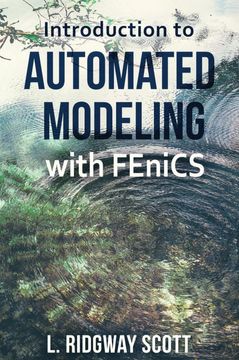Compartir
Introduction to Automated Modeling With Fenics (en Inglés)
L. Ridgway Scott (Autor)
·
Computational Modeling Initiative Llc
· Tapa Dura
Introduction to Automated Modeling With Fenics (en Inglés) - L. Ridgway Scott
$ 196.500
$ 272.920
Ahorras: $ 76.420
Elige la lista en la que quieres agregar tu producto o crea una nueva lista
✓ Producto agregado correctamente a la lista de deseos.
Ir a Mis Listas
Origen: Estados Unidos
(Costos de importación incluídos en el precio)
Se enviará desde nuestra bodega entre el
Miércoles 17 de Julio y el
Miércoles 24 de Julio.
Lo recibirás en cualquier lugar de Chile entre 1 y 3 días hábiles luego del envío.
Reseña del libro "Introduction to Automated Modeling With Fenics (en Inglés)"
Introduction to Automated Modeling with FEniCS explores solution of partial differential equations via the finite element method. It illustrates the use of automated software generation via the FEniCS Project systems. The book reviews most common types of partial differential equations arising in technical simulation. It is ideal for engineers and for computational and applied mathematicians.PDEs are used pervasively in science, engineering, and technology to model phenomena of interest. The most widely used technique to convert a PDE into a computable form is the finite element method. This book is primarily about PDEs as they are used in models. Our emphasis is on the diversity of PDEs that occur in practice, their features and their foibles. Our intent is to enable exploration of new models and to show how easily this can be done. However, this approach is not without caveats. We describe pitfalls in various aspects of the use of PDE models. We show how to be sure that a PDE model is well posed in many cases. In particular, we use this theory to understand appropriate boundary conditions.Secondarily, the book introduces basic concepts of numerical methods for approximating the solutions of PDEs. This is done so that the language used by software from the FEniCS Project can be properly understood. We limit the discussion of numerical methods as much as possible, except when it is essential to avoid catastrophes.A tertiary objective is to present some examples of the modeling process. One important type of model is derived by specializing a more general model. An important example of this is the plate model in structural mechanics. We show how the plate model is derived from the general elasticity model and indicate some issues that arise related to it. When relevant, we explain other modeling approaches as well. Ultimately, FEniCS can support an automated approach to modeling.
- 0% (0)
- 0% (0)
- 0% (0)
- 0% (0)
- 0% (0)
Todos los libros de nuestro catálogo son Originales.
El libro está escrito en Inglés.
La encuadernación de esta edición es Tapa Dura.
✓ Producto agregado correctamente al carro, Ir a Pagar.

